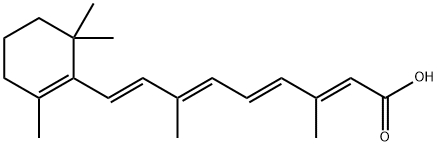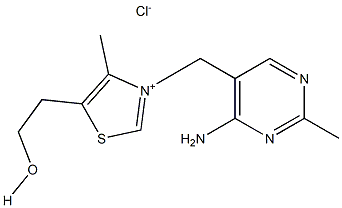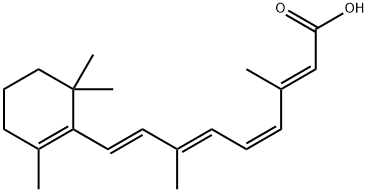Retinoic acid , 98% , 302-79-4
Synonym(s):
Tretinoin;Retinoic acid;ATRA;Vitamin A acid;Tretinoin, ATRA, Vitamin A Acid
CAS NO.:302-79-4
Empirical Formula: C20H28O2
Molecular Weight: 300.44
MDL number: MFCD00001551
EINECS: 206-129-0
| Pack Size | Price | Stock | Quantity |
| 500MG | RMB27.20 | In Stock |
|
| 1G | RMB39.20 | In Stock |
|
| 5G | RMB84.80 | In Stock |
|
| 25G | RMB282.40 | In Stock |
|
| 100G | RMB896.80 | In Stock |
|
| others | Enquire |
PRODUCT Properties
| Melting point: | 180-181 °C (lit.) |
| Boiling point: | 381.66°C (rough estimate) |
| Density | 1.0597 (rough estimate) |
| refractive index | 1.4800 (estimate) |
| storage temp. | -20°C |
| solubility | Practically insoluble in water, soluble in methylene chloride, slightly soluble in ethanol (96 per cent). |
| form | powder |
| pka | 4.73±0.33(Predicted) |
| color | yellow |
| biological source | synthetic (organic) |
| Water Solubility | insoluble |
| Sensitive | Light Sensitive |
| Merck | 14,8165 |
| BRN | 2057223 |
| Stability: | Store Dry in Freezer at -20°C for up to 1 year; in Solution at -20°C for up to 3 Months. |
| InChIKey | SHGAZHPCJJPHSC-ZVCIMWCZSA-N |
| LogP | 6.300 |
| CAS DataBase Reference | 302-79-4(CAS DataBase Reference) |
| EPA Substance Registry System | Retinoic acid (302-79-4) |
Description and Uses
all-trans Retinoic acid is a metabolite of vitamin A and a ligand for retinoic acid receptors (RARs) with IC50 values of 9, 3, and 10 nM for RARα, RARβ, and RARγ, respectively, in radioligand binding assays. It induces expression of a luciferase reporter in COS-7 cells expressing RARα, RARβ, or RARγ (EC50s = 169, 9, and 2 nM, respectively). all-trans Retinoic acid (17 nmol) reduces papilloma formation induced by phorbol 12-myristate 13-acetate (TPA; ) in mice. It reduces bile duct proliferation, hydroxyproline levels, and liver inflammation in a rat model of α-naphthylisothiocyanate-induced chronic cholestasis and reduces plasma levels of alkaline phosphatase and bile salts in the Mdr2-/- mouse model of cholestasis. all-trans Retinoic acid also reduces hepatic fat accumulation, triglycerides, body weight, and serum glucose levels in mice with Western diet-induced obesity.
retinoic acid (tretinoin) is a vitamin A derivative. It has demonstrated an ability to alter collagen synthesis, increase dermal hyaluronic acid levels, and stimulate fibroblast growth and the extracellular matrix. It is used for keratinization disorders and for treating acne. Retinoic acid’s anti-aging effect has been convincingly documented and it is often used for treating the visible signs of aging, though these results can take approximately 6 months to be visible. It is associated with a number of adverse effects, including irritation, photosensitivity, skin dryness, redness, and peeling. It should also not be used while pregnant.
Safety
| Symbol(GHS) |    GHS07,GHS08,GHS09 |
| Signal word | Danger |
| Hazard statements | H302-H315-H360FD-H410 |
| Precautionary statements | P202-P264-P273-P301+P312-P302+P352-P308+P313 |
| Hazard Codes | T,Xn,N |
| Risk Statements | 22-63-38-20/21/22-51/53 |
| Safety Statements | 53-26-36/37/39-45-36/37-61-24/25 |
| RIDADR | 3249 |
| WGK Germany | 3 |
| RTECS | VH6475000 |
| F | 7-8-16-23 |
| TSCA | Yes |
| HazardClass | 6.1(b) |
| PackingGroup | III |
| HS Code | 29362100 |
| Hazardous Substances Data | 302-79-4(Hazardous Substances Data) |
| Toxicity | LD50 (10 day) in mice, rats (mg/kg): 790, 790 i.p.; 2200, 2000 orally (Kamm) |





